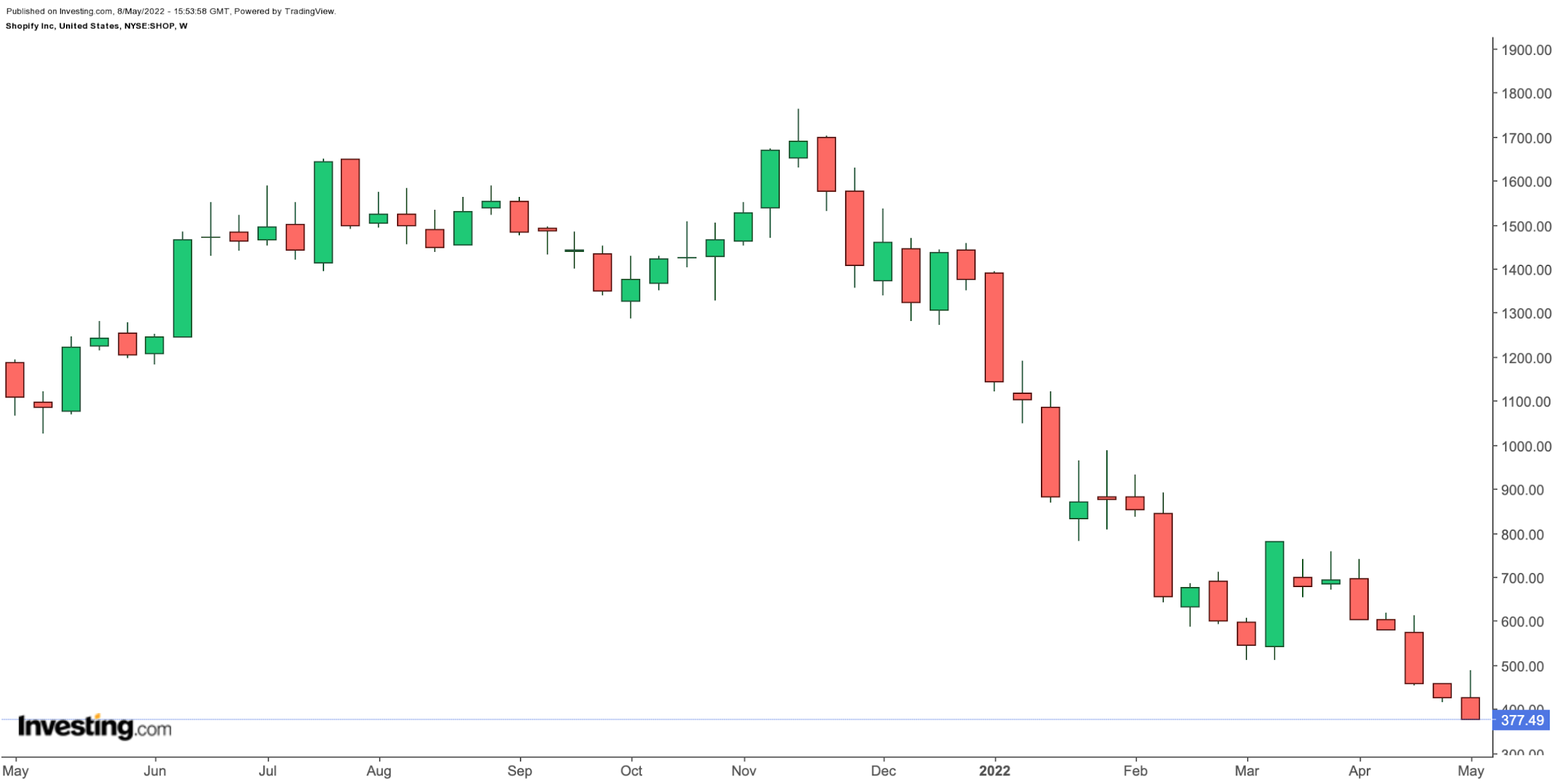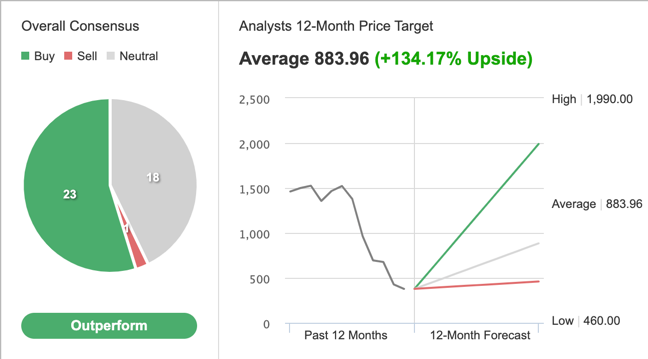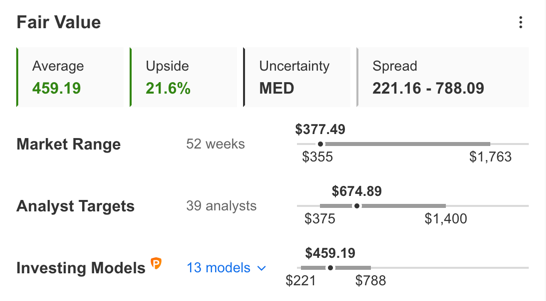- Shares of Shopify (TSX:SHOP) have declined more than 72% year-to-date
- Gloomy profitability prospects for the internet heavyweight
- Long-term investors could consider buying SHOP stock at current level
- Looking for more top-rated stock ideas to add to your portfolio? Members of InvestingPro+ get exclusive access to our research tools, data, and pre-selected screeners. Learn More »
Shareholders of the Canadian e-commerce giant Shopify (NYSE:SHOP) have seen the value of their investment decline more than 65% over the past 52 weeks and 72% year-to-date (YTD). By comparison, the Dow Jones Internet Commerce Index has lost 38% so far this year.

COVID-19 boosted e-commerce globally and Shopify was a beneficiary. However. in the last quarter of 2021, the online retail platform provider warned investors that it was “starting to see the intense levels of online sales companies garnered during the COVID-19 pandemic ease.”
And that warning has coincided with the recent moves in SHOP stocks. On Nov.19, 2021, Shopify shares hit an all-time high of $1,762. But, on May 6, they saw a multi-year low of $355.13, down roughly 75% over the past six months.
How Recent Metrics Came In
Shopify released Q1 figures on May 5. Overall results played out worse than analyst’s estimates. Total revenue came in at $1.2 billion, up 22% year-over-year (YoY) growth. Merchant Solutions drove top-line growth with $858.9 billion, up 29% YoY. Subscription Solutions revenue increased by only 8%.
Meanwhile, Gross Merchandise Volume increased 16% YoY to $43.2 billion. Adjusted net income plunged to $25.1 million, or 20 cents per diluted share, down from $254.1 million, or $2.01 per diluted share, in the prior-year period.
On the results, President Harley Finkelstein commented:
“While we’ve experienced massive macro shifts since the start of the pandemic, the one mainstay has been that Shopify is the commerce platform of choice for merchants in any environment, with the ability to support commerce on any surface.”
Management anticipates YoY revenue growth to come in lower in the first half and highest in the fourth quarter of 2022. Moreover, Merchant Solutions revenue growth is expected to come in more than twice the rate of Subscription Solutions revenue growth YoY, implying that gross profit dollar growth will trail revenue growth.
Prior to the release of the quarterly results, Shopify stock was trading at around $485. It’s now changing hands for $377.49, a decline of around 22%. In other words, investors were not pleased with the results which showed declining sales yet growing costs. Meanwhile, the company's market capitalization (cap) currently stands at $47.5 billion.
What To Expect From Shopify Stock
Among 42 analysts polled via Investing.com, SHOP stock has an "outperform" rating, with an average 12-month price target of $883.96 for the stock.

Source: Investing.com
Such a move would suggest an increase of 134% from the current price. The target range stands between $460 and $1,990.
However, according to a number of valuation models, including P/E or P/S multiples or terminal values, the average fair value for SHOP stock on InvestingPro stands at $459.19.

Source: InvestingPro
In other words, fundamental valuation suggests shares could increase by around 21.5%.
We can also look at SHOP’s financial health as determined by ranking more than 100 factors against peers in the Information Technology sector. In terms of cash flow and growth, it scores 4 out of 5. Its overall score of 3 points is a good performance ranking.
At present, SHOP’s P/E, P/B, and P/S ratios stand at 261.9x, 4.9x, and 9.9x. Comparable metrics for peers stand at 10.5x, 7.4x, and 8.6x.
As part of the short-term sentiment analysis, it would be important to look at the implied volatility levels for Shopify options as well. Implied volatility typically shows traders the market's opinion of potential moves in a security, but it does not forecast the direction of the move.
SHOP’s current implied volatility is about 7% lower than the 20-day moving average. In other words, implied volatility for Shopify stock is trending lower, while options markets suggest potentially less choppiness ahead.
Our expectation is for SHOP stock to trade in a wide range and build a base between $340 and $380 in the coming weeks. Afterwards, Shopify shares could potentially start a new leg up.
Adding SHOP Stock To Portfolios
Shopify bulls who are not concerned about short-term volatility could consider investing now. Their target price would be $459.19, as indicated by fundamental models.
Alternatively, investors could consider buying an exchange-traded fund (ETF) that has SHOP stock as a holding. They include:
- ARK Fintech Innovation ETF (NYSE:ARKF)
- First Trust Dow Jones International ETF (NASDAQ:FDNI)
- Roundhill MEME ETF (NYSE:MEME)
- Franklin Disruptive Commerce ETF (NYSE:BUYZ)
- SoFi Gig Economy ETF (NASDAQ:GIGE)
Finally, investors who expect SHOP stock to bounce back in the weeks ahead could consider setting up a bull call spread.
Most option strategies are not suitable for all retail investors. Therefore, the following discussion on SHOP stock is offered for educational purposes and not as an actual strategy to be followed by the average retail investor.
Bull Call Spread On Shopify Stock
Intraday Price At Time Of Writing: $377.49
In a bull call spread, a trader has a long call with a lower strike price and a short call with a higher strike price. Both legs of the trade have the same underlying stock (i.e., Shopify) and the same expiration date.
The trader wants SHOP stock to increase in price. In a bull call spread, both the potential profit and the potential loss levels are limited. The trade is established for a net cost (or net debit), which represents the maximum loss.
Today’s bull call spread trade involves buying the June 17 expiry 380 strike call for $41.60 and selling the 390 strike call for $36.85.
Buying this call spread costs the investor around $4.75, or $475 per contract, which is also the maximum risk for this trade.
We should note that the trader could easily lose this amount if the position is held to expiry and both legs expire worthless, i.e., if the SHOP stock price at expiration is below the strike price of the long call (or $380 in our example).
To calculate the maximum potential gain, we can subtract the premium paid from the spread between the two strikes, and multiply the result by 100. In other words: ($10 – $4.75) x 100 = $525.
The trader will realize this maximum profit if the Shopify stock price is at or above the strike price of the short call (higher strike) at expiration (or $390 in our example).
Bottom Line
In recent months, Shopify stock has come under significant pressure. Yet, the decline has improved the margin of safety for buy-and-hold investors who could consider investing soon. Alternatively, experienced traders could also set up an options trade to benefit from a potential run-up in the price of SHOP stock.
Interested in finding your next great idea? InvestingPro+ gives you the chance to screen through 135K+ stocks to find the fastest growing or most undervalued stocks in the world, with professional data, tools, and insights. Learn More »
